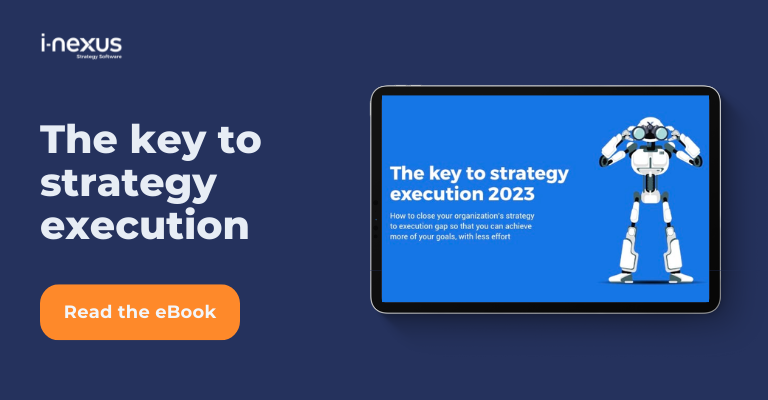Achieving strategic goals requires effective management at both portfolio and program levels. Yet all too often, a lack of central coordination leads to muddled priorities and ineffective execution. How can we do better?
Written by: James Milsom, Head of Marketing
Strategic initiatives are just like all humanity’s other grand designs.
Their success or failure depends on the harmonious alignment of three guiding stars:
- The organizational structures and processes needed to coordinate the work
- The tools, technologies, and materials needed to deliver the work, and
- The people with the skills, agency, and motivation to do the work.
All three are important, but the people aspect is the most difficult to get right.
You need to build a culture that gives participants the power and confidence to collaborate effectively and make the right decisions together.
This is the key to success not only at the program delivery level but also in managing the entire portfolio of programs to achieve the organization’s strategic goals.
So, what are the magic ingredients for nurturing teamwork in program and portfolio management (PPM)?
In part, they really are magic: nobody can fully explain why some teams bond instantly while others never really gel.
Nevertheless, there are numerous tools, structures, and practices you can adopt to help create an environment where teamwork and collaboration can easily take root.
Today, we're going to run through six ideas with which you can strengthen program and portfolio management.
1) Standardize your templates and processes
To make sense of progress and results across your entire portfolio, it’s vital for all the individual programs to speak the same language, calculate metrics in the same way, and use the same format when they report up to the portfolio management level.
Standardization also helps people working at the program level to get on board faster when they join a new project, because they already know the basic structures and understand what is expected of them.
Equally, if one program needs to be sunset or another suddenly requires additional resources, it’s easy to move people between teams with minimal friction.
2) Forecast your demand for resources
One of the most common root causes of failure in strategic initiatives is that the right people aren’t available at the right time.
Scheduling clashes are a common cause of delays, and if highly skilled staff are pulled between too many different commitments, they can’t be effective team members on strategic programs.
In a world of finite resources, it’s impossible to avoid clashes altogether, but the right approach can make scheduling much more manageable.
If each program regularly checks in with the portfolio management team with data on current resource utilization and upcoming needs, it’s possible to build accurate forecasts and ensure that each team has the people it needs, when it needs them.
3) Be transparent about budgets and costs
In the PPM space, successful teamwork isn’t just about delivering program milestones on schedule.
The individual programs are part of a broader conversation at the portfolio level, where the goal is to maximize the achievement of overall strategic objectives while minimizing cost, risk, and delivery time.
Defining a structured way for finance teams, budget holders, and program owners to open lines of communication around program costs, budget planning, and benefit delivery is the key to fostering teamwork at this macro level and helps to ensure that people don’t put the needs of their program ahead of the good of the organization as a whole.
4) Establish a regular cadence for updates
Teamwork doesn’t happen in the dark.
If each program only reports its status and progress sporadically, there’s no way for either portfolio management or other program managers to coordinate their own work, or to collaborate with teams outside of their own silos.
By contrast, if each team provides regular updates on delivery and metrics, it’s easier to build a detailed picture of performance, identify anticipated blockers, and take proactive steps to keep the entire portfolio on track—so the whole extended team is moving in the same direction.
5) Be rigorous about prioritization
One of the most effective ways to destroy a collaborative PPM culture is to play favorites.
Some programs will always be more important or higher-profile than others, but it’s critical to base that prioritization on well-defined, well-understood metrics, not on the whims of senior managers or the office politics of competing program owners.
Bring your program managers, function leads, and key stakeholders into the discussion early to establish a data-driven, rule-based prioritization framework, and then embed that framework into your systems and processes so that everyone can see that decisions are being made fairly.
6) Encode successful practices at the system level
In theory, you could implement all the tips in this article using simple documents, spreadsheets, and email—but in practice, this would place an unbearable administrative burden on everyone involved in PPM.
A far better approach is to build on an industry-proven strategy execution platform that can centralize your PPM data, enforce good practices at the software level, and act as a hub for communication and collaboration both within and between program delivery and portfolio management teams.
Evolve your Program and Portfolio Management
In a world defined by disruption, portfolios and programs can no longer sit detached, failing to provide a crystal-clear picture of performance, delivery, risks, and opportunities.
Perfecting the balancing act of investments, priorities, and resources, while aligning work to strategic direction, and enabling agile decision-making for rapid changes, requires a collaborative solution designed for modern practices.
It’s time to evolve your program and portfolio management with i-nexus. Click here to learn how.
Learn more about Program and Portfolio Management
Click here to learn more about continuous improvement or take a look at these content recommendations:
- Leading Strategy Execution: Strategy Execution comes with great responsibilities and that calls for an even greater leader. Strategic leaders are the captain of your organizational ship and this is why they are central to the vessel’s journey.
- Harnessing the Voice of the Customer: Here’s why breaking through your performance barriers starts with your customer's voice.
- Help your business become Agile: Discover why an adaptive approach to strategic planning and execution begins with Operational Excellence.
About the author
James Milsom is Head of Marketing at i-nexus. James has wide-ranging experience of markets such as telecommunications, energy, education and software.
As Head of Marketing, his drive is to raise awareness and understanding of the challenges facing enterprises in delivering strategic objectives and transformation amidst changing markets and the obstacles traditional tools and methods present leaders.
If you’d like to talk more about Strategy Execution, reach out to James on james.milsom@i-nexus.com or connect with him on LinkedIn for the latest insights.


.jpg?width=352&name=seminar-594125_1920%20(1).jpg)

